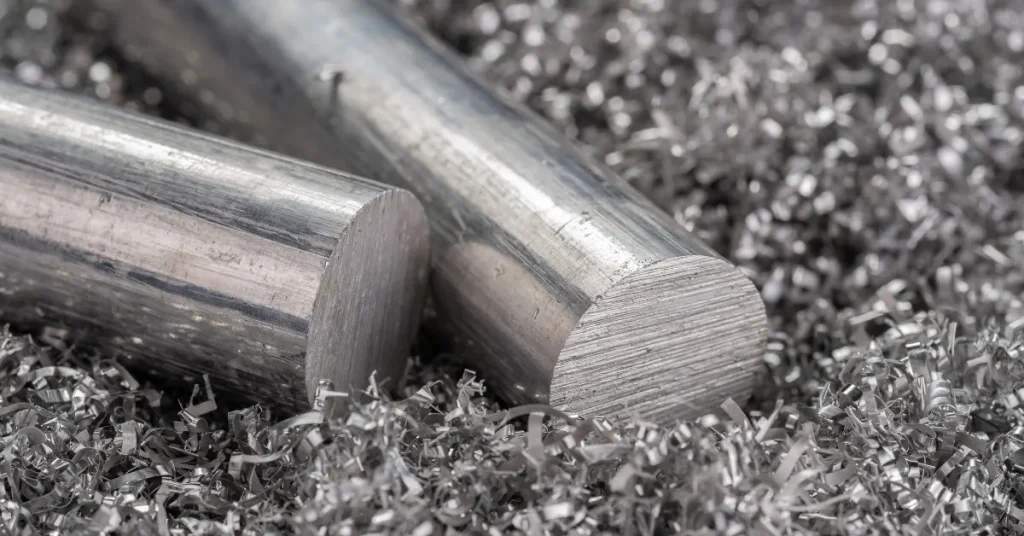16 gauge aluminum has a thickness of approximately 0.0508 inches or 1.29 millimeters. It’s a versatile material commonly used in various industries.
Understanding the dimensions of aluminum gauges is critical for professionals working with sheet metal in manufacturing, construction, and design.
The thickness of 16 gauge aluminum offers a balance between pliability and strength, making it suitable for many applications.
Whether used in creating custom automotive parts, crafting sturdy yet lightweight frames, or fashioning HVAC components, knowing the precise thickness of 16 gauge aluminum ensures exact specifications are met.
This gauge is preferred for projects where a moderate level of durability is needed without the excess weight of thicker metals.
Having a firm grasp of material dimensions like the thickness of 16 gauge aluminum aids in quality control, ensuring that products meet safety standards and function as intended.

Gauge Systems And Aluminum Measurements
Are you wondering about the thickness of 16 gauge aluminum? Let’s explore the fascinating world of metal thickness.
Gauge systems guide us in measuring metals precisely. These systems can be tricky. This post will unwrap the mystery behind gauge measurements and how they apply to aluminum.
The Origin Of Gauge Measurements
Gauge numbers have a unique history. Initially, they referred to the number of times a metal was passed through a die to be thinned.
These numbers don’t match any measurement scale directly. Here’s an intriguing fact: The higher the gauge number, the thinner the metal!
Comparing Different Metal Gauge Standards
Not all metals share the same gauge standards. Thickness can vary greatly between materials, like steel, aluminum, and copper. Below is a comparative look to help you understand the differences.
| Gauge Number | Thickness (Aluminum) | Thickness (Steel) |
| 16 | 0.051 inch | 0.0598 inch |
| 18 | 0.0403 inch | 0.0478 inch |
| 20 | 0.032 inch | 0.0359 inch |
Why the difference? It’s because each metal has unique properties. The gauge system for aluminum is not directly transferable to steel or copper. An aluminum 16 gauge is thinner than the 16 gauge of steel. A table makes these differences clear and easy to understand.
Decoding The Numbers: What Is 16 Gauge?

Many metal thicknesses come in ‘gauge’ numbers. Understanding 16 gauge aluminum is crucial for industry professionals and DIY enthusiasts.
Aluminum gauges can be puzzling. This section breaks down what 16 gauge means for aluminum sheets. Dive into gauge numbers. See the practicality of aluminum in projects.
Gauge numbers indicate metal thickness. The lower the gauge number, the thicker the metal. For aluminum, 16 gauge offers a balance. It is sturdy yet workable. Ideal for various applications. Look below for a quick peek at how gauges translate into thickness.
- Lower gauge – Thicker metal
- Higher gauge – Thinner metal
Understanding the exact thickness is vital. 16 gauge aluminum equals 1.29 mm or 0.0508 inches in thickness. Here’s a simple chart to help visualize different gauge measurements.
| Gauge Number | Thickness (Inches) | Thickness (Millimeters) |
| 14 Gauge | 0.0641 | 1.63 |
| 16 Gauge | 0.0508 | 1.29 |
| 18 Gauge | 0.0403 | 1.02 |
| 20 Gauge | 0.0320 | 0.81 |
The Thickness Of 16 Gauge Aluminum
Understanding the specific thickness of 16 gauge aluminum is crucial for various projects. It’s a common material used in many industries. Knowing the exact thickness allows for precise calculations and ensures the right aluminum grade for the job.
Standard Thickness For 16 Gauge Aluminum
16 gauge aluminum typically refers to 0.0508 inches or 1.29 millimeters in thickness. This standard measurement is set for ease of reference. Yet, actual measurements can slightly vary. Different types of aluminum might also have specific industry standards. Here’s a quick view:
| Measurement System | Thickness |
| Inches | 0.0508″ |
| Millimeters | 1.29mm |
Tolerances And Variations In Thickness
Not all 16 gauge aluminum sheets will be the exact same thickness. Manufacturers allow a tolerance level. Thickness can vary slightly without affecting quality. Tolerance levels are often mentioned in the product specification. These variations account for:
- Manufacturing processes
- Temperature changes
- Finishing treatments
For precise applications like aircraft or medical devices, ensure the tolerance level suits the project’s needs.
Applications Of 16 Gauge Aluminum
When talking about the thickness of metals, ‘gauge’ is a term often used. Not many know how thick 16 gauge aluminum is. Imagine three sheets of copy paper. That’s near the thickness of 16 gauge aluminum – about 1.3 millimeters. Such aluminum is firm yet bends easily. Spectacular for many tasks! Let’s explore where 16 gauge aluminum really shines.
Typical Uses In Construction And Industry
16 gauge aluminum is a sturdy player in the building and manufacturing game. See where it’s used:
- Durable roofing and siding – it stands up to weather.
- Stiff fascia panels – for sharp-looking building fronts.
- Strong ductwork – it keeps air flowing right.
- Solid architectural frames – for modern, sleek designs.
- Supportive framework in engineering wonders.
Why Choose 16 Gauge For Your Project?
All set for a project and wondering about the best metal to use? Think of 16 gauge aluminum. Here’s why:
- Right mix of strength and flexibility – perfect for bending and shaping.
- Resists rust – your project lasts longer with no rust in sight.
- Lightweight – making it easy to handle and fix into place.
- Great finish – paint or treat it for a look that wows.
Working With 16 Gauge Aluminum

Working with 16 Gauge Aluminum offers a fantastic blend of malleability and strength, suitable for many metalworking projects. With a thickness of approximately 0.0508 inches, it strikes the right balance for shaping and durability.
Whether for construction, automotive needs, or artistic endeavors, understanding the best practices for manipulating this versatile material is vital.
Machining And Molding Techniques
When working with 16 gauge aluminum, variety is key. Techniques can range from traditional hand tools to advanced machinery. For precise cutting, one could use:
- CNC machines for detailed and repeatable designs
- Shears for straight, clean cuts
For molding, suitable methods include:
- Bending with a press brake for sharp angles
- Rolling for creating curves and cylinders
Each technique ensures 16 gauge aluminum maintains its integrity while achieving the desired shape.
Safety Tips And Tools Required
Safety is paramount when working with aluminum. Start with personal protective equipment (PPE) such as:
- Gloves to protect hands from sharp edges
- Goggles to shield eyes from debris
Important tools for handling 16 gauge aluminum include:
| Tool | Use |
| Tin snips | For hand-cutting small sections |
| File | For smoothing out edges |
Ensure workspace ventilation to avoid inhaling any airborne particles. Always secure materials properly to avoid slippage and use tools as intended to prevent mishaps.
Purchasing Tips For 16 Gauge Aluminum
Purchasing Tips for 16 Gauge Aluminum guide buyers through selecting the right thickness for their projects. 16 gauge aluminum is approximately 0.0508 inches thick. Knowing the exact thickness helps in making precise decisions for construction or crafting jobs.
Finding Quality Suppliers
Identify suppliers that:
- Offer quality certifications for their materials.
- Have good market reputation and reviews.
- Provide material traceability and origin details.
- Maintain consistent stock for reliable supply.
Check supplier portfolios and request sample materials.
Cost Considerations For Bulk Orders
Buying in bulk often reduces costs. Factors that influence price include:
| Factor | Influence on Price |
| Market Demand | Higher demand can increase prices. |
| Aluminum Grade | Certain grades may be more expensive. |
| Order Quantity | Larger orders typically cost less per unit. |
| Shipping Fees | Bulkier orders may lead to higher shipping costs. |
Negotiate prices with suppliers for large quantities.
FAQs About How Thick Is 16 Gauge Aluminum
How Thick Is 16 Gauge Aluminum Sheet?
A 16 gauge aluminum sheet typically measures 0. 0508 inches or 1. 29 millimeters in thickness.
How Thick Is 16 Gauge Material In Inches?
A 16 gauge material measures approximately 0. 0625 inches in thickness.
Which Is Thicker 14 Or 16 Gauge Aluminum?
14 gauge aluminum is thicker than 16 gauge. Gauge numbers decrease as material thickness increases.
Is 16 Gauge Aluminum Thicker Than 18 Gauge?
Yes, 16 gauge aluminum is thicker than 18 gauge. The lower the gauge number, the thicker the material.
Conclusion
Understanding the specifics of 16 gauge aluminum’s thickness helps in many applications. At 0. 0508 inches, it strikes a balance between durability and workability.
Remember this measure when planning projects or purchasing materials. This knowledge ensures your endeavors are not just successful, but also precise.
Choose wisely and create masterfully.
Resources:
1. https://www.grandrapidsmi.gov/Government/Departments/Development-Center/Frequently-Cited-Mechanical-Issues
